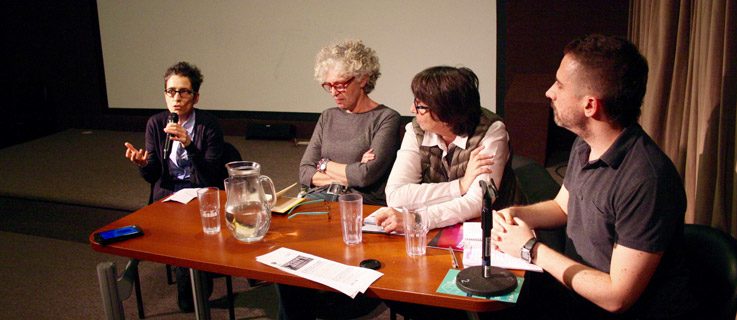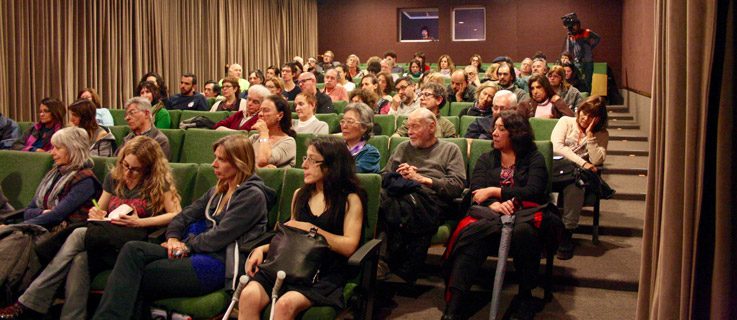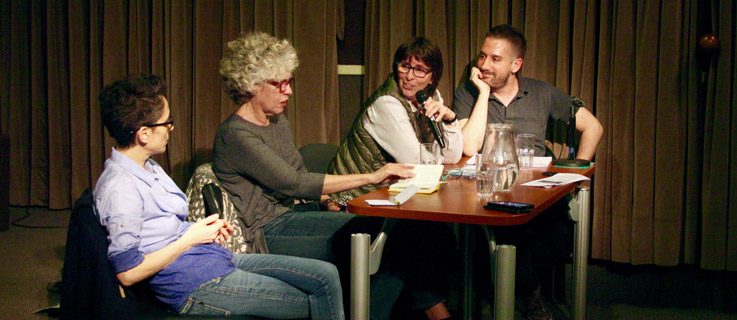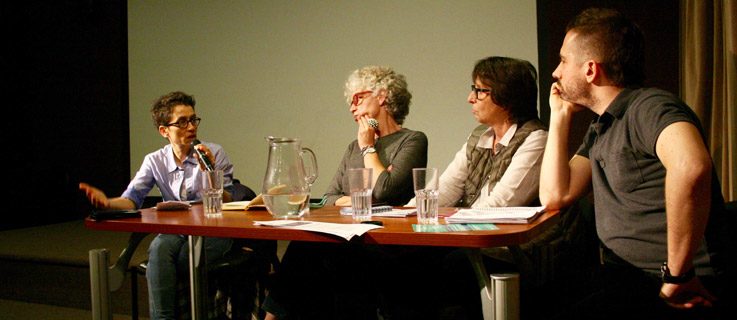In this discussion regarding the documentary ‘Austerlitz,’ several questions arise regarding the role of the extermination camps and memorials in times of mass tourism.
-
 © Gustavo Correa/Goethe-Institut Buenos Aires
© Gustavo Correa/Goethe-Institut Buenos Aires
Filmmaker Albertina Carri; the director of the ESMA Memory Site Museum, Alejandra Naftal; the director of the Memory Park, Nora Hochbaum, and journalist Julian Gorodischer.
-
 © Gustavo Correa/Goethe-Institut Buenos Aires
© Gustavo Correa/Goethe-Institut Buenos Aires
“This movie brings me to two key concepts: silence and sinister things,” a woman explains. Our partners in this place experienced sinister things, but they couldn’t talk about them.”
-
 © Gustavo Correa/Goethe-Institut Buenos Aires
© Gustavo Correa/Goethe-Institut Buenos Aires
“I’m concerned about the way it looks at people inside the concentration camp. At times I thought it was a disrespectful gaze on human beings, as if they were zombies, the undead walking around": Nora Hochbaum
-
 © Gustavo Correa/Goethe-Institut Buenos Aires
© Gustavo Correa/Goethe-Institut Buenos Aires
"What are those people coming here for? What do they do what those pictures? Do they post them on Facebook? What do you do with the pictures that you take in a concentration camp? It’s weird ... Why would you take a picture in a concentration camp?”: Albertina Carri.
“To observe is not to judge,” I say to myself from the discomfort that grows minute by minute, as if the camera of Ukrainian filmmaker Sergei Loznitsa in
Austerlitz (Germany, 2016) poked around the paradoxical behavior of the people that visited the concentration camp of Sachsenhausen in Oranienburg, 35 kilometers from Berlin. I hate the “military” sound of the footsteps of visitors marching with their bottles of water, with their mobile phones, with their hats and sunglasses to protect themselves from an omnipresent sun. There’s a disturbing background noise that combines babbling in German, in English, in Spanish, in several languages; a Babelian murmur that mixes with the songs of the birds and the sound of the wind that stirs the branches of the trees. What photographs are taken in a space like this, beyond the urgent need, in times of social networks, to capture an image that says “I was here?” Perhaps the intent is to catch a vestige, as slight as it may be, of the horror experienced in this field, when they take selfies in front of the phrase “
Arbeit macht Frei” (“Work will set you free”)?
“Showering was a luxury,” says one of the guides in Spanish. They would go into that room, where there was a water pipe and also a gas pipe. Why would they do this using a shower? Nobody is afraid of showers. Why oppose resistance if they are only leading me to the shower? “They murdered them right there,” she points at a point outside the frame of the camera, “and removed them using that ramp.” Then the voice of another guide is heard, also speaking Spanish, explaining what was done with the remains of the burned bodies: “The ashes were stored in the last room and then spread over the fields as fertilizer.” Tourism in the foundations of extermination, something terribly normal, perhaps gives a new meaning to the “banality of evil,” a term coined by German philosopher Hannah Arendt. Some people—tourists, visitors, guides—seem to act within the rules of the system they belong to without paying a thought to their actions.
“What does it mean when a space like this shows a film like Loznitsa’s?” asks journalist Julian Gorodischer in the Raymundo Gleizer microcinema at the Haroldo Conti Cultural Center for Memory before opening the debate on “artistic poetics and the future of memory” with the director of the Memory Park, Nora Hochbaum, the director of the ESMA Memory Site Museum, Alejandra Naftal, and filmmaker Albertina Carri. This is the second activity in “The Future of Memory,” a project driven by the Goethe-Institut aimed at opening an alternative space to think about pressing issues on the memory of dictatorships, violence, and armed conflict during the past decades in Argentina, Brazil, Chile, Colombia, Uruguay, and Peru.
Nora, who saw the movie for the first time, doesn’t know if she’s angry or if she liked it. “All I know is that I’d kick out all the guides,” admits the director of the Memory Park, and warns that this is a film that achieves its goal of raising concern among the audience. “I’m concerned about the way it looks at people inside the concentration camp. At times I thought it was a disrespectful gaze on human beings, as if they were zombies, the undead walking around. He wants viewers to feel concerned about the use of spaces of memory that have connotations regarding death, terrorism ,or holocausts.”
Alejandra Naftal, director of the ESMA Memory Site Museum, stresses that it’s a “totally deceitful” movie. “It gives you no information about anything because you don’t know what the public is watching, what they are reading. Many of them look like zombies, but others do not. There are a couple of close-ups of faces where you say that person saw something, something happened to them. The camera never gets inside a space, it is always outside. We as audience have all the information, so we see a lack of respect. The fact that it’s in black and white has to do with that; imagine this movie full of colors, with the T-shirts, bags, hats. It would be even stronger,” says Alejandra. “For those of us who work in these spaces, discomfort and comfort have to be permanent; if it’s uncomfortable all the time, you turn away people who come here to have an experience. If you give them everything figured out, then it’s Disneyland for them. The film, without showing anything, reflects what’s comfortable and uncomfortable. He’s playing with those who see the movie, not with those who are visiting the camp,” says the director of the ESMA Memory Site Museum.
Albertina Carri, director of
The Blondes (2003) and
Rustlers (2016), among other films, and creator of the video installation
Operation Failure and Sound Recovered at Memory Park, defends Loznitsa and describes the film as an “observation documentary.” “There’s always manipulation in terms of what moment he uses the camera and what day; he chooses a certain temperature, a certain weather, and all those bodies have no reflection on what the sun might have meant for that camp. But this is not the responsibility of the filmmaker; he places the camera in that place and narrates that. I even find it very respectful not to enter the places: he stays at the entrance watching how they come in and go out,“ the filmmaker adds.
The guides tell the story with their words, with their philosophical worldview, but they do mention what happened there. In fact, the Spanish guide is quite hard, because she finishes the narration of a very dramatic moment regarding the burning of bodies, how they were taken away and killed, and immediately afterwards she says ‘let’s eat a sandwich now,’ recalls Albertina. “What happens to us when we watch these hordes of people with hats, sunglasses, and cameras? When I saw the film for the first time I thought: ‘What a shame that it’s not in color!’, but that would be a scandal. Black and white softens the look, otherwise it’d be outrageous to see. Black and white helps to stifle that feeling of zombies and trivialization, a certain lack of respect. What are those people coming here for? What do they do what those pictures? Do they post them on Facebook? What do you do with the pictures that you take in a concentration camp? It’s weird ... Why would you take a picture in a concentration camp?”
Goethe-Institut Buenos Aires
Alejandra describes how consensus took shape around the ESMA Memory Site Museum. “As a public institution of the Argentine State, we had to build a story in a place where the two fundamental tools were the building, as material evidence, and the voices of the survivors, who are the only ones that could narrate what happened here. We opted for a path that was necessary, one that was informational, educational, documentary, in order to then appeal to the experience. Why do people go to these places? They have everything online in virtual form. People go there to have an experience; they have so much virtuality that they need to go and see the places for themselves. They do not seek knowledge, they don’t go there to learn what happened in that concentration camp. They go there to share an experience with other people.”
Julian notes that there is a bridge between Loznitsa’s scraps—regarding the fact that nearly all of the film is made out of field, made of images that perhaps a traditional documentary would have scrapped—and Carri’s work with movie scraps in the show he presented at the Memory Park. “What has been discarded, unwanted, is it a good road to access both knowledge and artistic expression when it comes to tragic memory?” asks the reporter. The filmmaker confirms that she is particularly interested in the idea of scraps because “it’s what they don’t show you, like (Jacques) Derrida’s claim requesting that the news show us everything unedited in order to rewrite the world.” “I’ve been working with unedited material, both in scraps with the monster that I made at Memory Park, and in my movie
Rustlers, in which I worked with material that was not necessarily on air at the moment.”
The director of
The Blondes noted differences between the Park and the ESMA Memory Site Museum. “The space that operates here used to be a clandestine center, a concentration camp; it is not a monument to the victims, it needs to build a different type of story. For me, the film is not about how the institution decides to tell this story, but about what’s happening today, how people get to that place. The camera goes around those scraps, around those edges, and it’s never very clear where you are.” One anecdote illustrates a knot of indifference and apathy that may be difficult to untie. “When I was mounting the show at the Park, a guy came by with his family and told his wife: ‘Names, names, names, a bunch of names... I don’t know what those names are.’ I froze. How come he doesn’t know? There are signs everywhere that say this is the Monument to the Victims of State Terrorism. There’s a point where it’s not the responsibility of the institution or the filmmaker, but of the bestial capitalism we live in,” explains Albertina.
Nora is reluctant to think that tourism and massiveness are bad. “The big challenge lies in the institution, in the educational programs, in what happens inside these places. The Park was not a clandestine center, it was not a concentration camp, so we address it in a different way: it was conceived as a space for beauty, for tribute, for memory, coordinated with arts and education. The city tour bus has a stop in the Park and people get off there and take pictures.” The director of the ESMA Memory Site Museum states that it’s preferable to undergo the challenge of massiveness. “I want many people to come here. At the Site we have a video at the entrance that is aimed at introducing people to the context of this place; we give them some clues to be a little moved and then behave: people were tortured here, people were killed here, people were thrown to the sea alive from here... Then we tell them that this is legal evidence, that the walls cannot be touched, that they can’t eat here, that they can’t run. We show them the no-no’s, but we transform them, because they’re visiting something important,” stresses Alejandra.
The moderator of the debate mentions the trend of “disrespect to the Holocaust,” in the sense of getting out of a canonical gaze and proposing a satirical vision. “Is this something to do with the passage of time, with the distance that separates us from the event? Does it have to do with the permissions given by being linked to the victims?,” asked Julian. “Traumatic events such as the last dictatorship take a lot of time to be overcome,” Albertina responds. In the beginning of the post-dictatorship era, certain types of speeches were required to rebuild the chances of memory, truth, and justice. As time went on, the voices of the children appeared. That was the breaking point, where the gaze began to be a different one. The other day I was reading in an artists’ catalogue that ‘life is not sacred, audacity is sacred.’ The point of art is to reflect from fearlessness, to break with the canon and make it part of life to get close to some possibility of mourning.”
Many people need to voice their concerns. “This movie brings me to two key concepts: silence and sinister things,” a woman explains. Our partners in this place experienced sinister things, but they couldn’t talk about them.” A young woman recalls the movie “opposite” to Loznitsa’s:
The Plot (2010), by Jonathan Perel. “There’s no need to fear the mass,” he proposes. One achievement of German politics is the fact that this concentration camp has become a must-see tourist spot, it is mandatory for people to have this experience, no matter if it is modified or not.” A man hits the spot of the problem. “Humanity is permanently living in repeated holocausts. Humanity is a history of massacres. Argentina is an example of this situation,” he says. There are wounds that are not sutured and don’t heal. There are crimes and damages that are irreparable and any attempt of closure is doomed to failure. “To observe is to exhume the veils of what ‘normal’ is in order to inquire in the darkness,” I write down on my notebook, with the modest intuition that the future is always open and uncertain when we speak of memories.